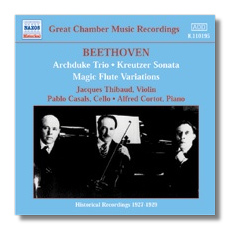
The Internet's Premier Classical Music Source
Related Links
- Beethoven Reviews
- Latest Reviews
- More Reviews
-
By Composer
-
Collections
DVD & Blu-ray
Books
Concert Reviews
Articles/Interviews
Software
Audio
Search Amazon
Recommended Links
Site News
 CD Review
CD Review
Ludwig van Beethoven

- Trio for Piano, Violin and Cello #7 in B Major "Archduke"
- Violin Sonata #9 in A Major "Kreutzer"
- 7 Variations in E Flat Major from Die Zauberflöte for Cello & Piano
Jacques Thibaud, violin
Pablo Casals, cello
Alfred Cortot, piano
Naxos 8.110195
"There is really not a whole lot to say here. They don't play like this any more. The Beethoven sounds more like Schubert. The playing offers, "Cortot's tonal subtlety, Thibaud's refinement and elegance, and Casal's powerful attack and nobility of phrase – which nevertheless fused together into a remarkable unanimity…" as offered by Lionel Slater in his notes. The sound is, of course, monaural, and the 1926 Schubert is slightly more distant than the 1928 Beethoven recording. There are no comparisons, however, for this is the real thing. The players here are making music, not just playing it. 'Nuff said."
Those are the words I wrote when I reviewed this "Archduke" released on EMI's GROC recording coupled with Schubert's Trio. Now we have a differently remastered recording differently coupled. It is good to have the additional items added to my TC2 collection, but does it sound good enough to add it to your collection? These are the thoughts and question I am pondering as I am about to explore this latest Naxos 'Great Recordings' CD.
Okay, the answer is quick to come. EMI is working from original source material and so the fidelity is inherently better. This is not the end of the matter, however, because there are two other significant differences in the sound on these releases. It is not a matter of surface noise, the Naxos has some but it is not distracting. More important, the Naxos sounds more distant. This robs the recording of its immediacy and involvement. That is, the EMI recording grabs my attention whilst the Naxos leaves me a bit uninvolved. The biggest difference, however, is the relative perspective of the soloists. In the EMI Cortot is prominent. In fact, it was my listening to this disc that brought him to my attention and I went out and purchased every other generally available disc with him playing. This is not a bad thing because Casals and Thibaud are certainly not slighted, but less in the forefront. Then we come to the Naxos and now Casals is definitely prominent. Cortot can be heard but is not the dominant soloist. This is not necessarily bad; Casals certainly has things to offer not as clearly delineated in the EMI recording.
The main point is that we have here a situation where we are and are not listening to the same recording at the same time are we? I am not sure why the producers selected this difference in relief. I know how it can be effected and I can hear the affect. The original source material, the system they are using and their own thematic content, to coin a phrase from the philosopher Gerald Holton, certainly are indices in this matrix. The gestalt, even though the parts are essentially the same, is different. So what we have here is a proof of the theory of gestalt (the result [and a result is not the same as an end ] is greater than the sum of the parts).
Sorry about the philosophical digression. I can't help it sometimes. Getting back to the music and recording, I can say that at this point I prefer the EMI disc but I can't say that opinion is not going to change. I know that the Naxos recording lessens my appreciation for Cortot's part in the dialogue even though this is replaced by a stronger voice from the cellist. Given the additional items on the disc and the low price I would certainly think this is not a bad disc to add to your collection. In fact, it is worth the price just to study the way a different recording can be achieved from the same material. In fact, you might have a different feeling about the two recordings than I do.
A final question remains. Am I still as swept away by this recording as I was? I do feel that these artists are making music and not just playing it. I do appreciate the interplay of the dialogues. It is different, however different.
Copyright © 2002, Robert Stumpf II


















